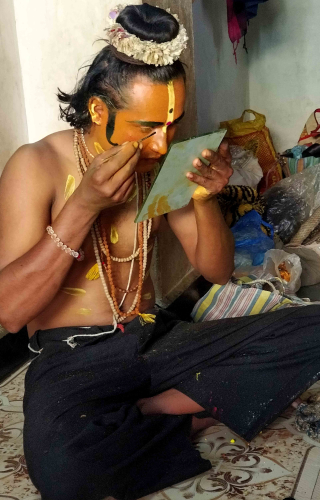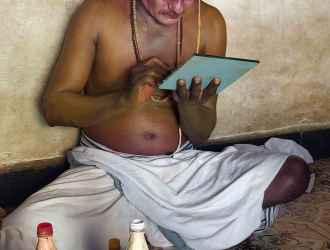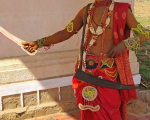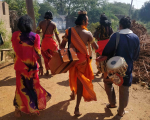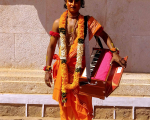The bahurupis of Karnataka, categorised under the OBC category by the state’s census reports, are itinerant performers of hagalu vesha or pagati vesha. Also known as the ‘sadhus of the cemetery’, they impersonate mythological characters and stage amusing episodes that also comment on daily events.
While a sizeable number of this scattered group of artists belongs to the Lingayat community, it has been said that there are also Muslim performers among them. As is the practice of bahurupis elsewhere in India, they are nomadic and do not make permanent homes. Often without identification documents—and therefore unable to avail official support systems—they end up doing odd jobs like selling plastic knick-knacks or seek alms. Yet, in a world where entertainment variables have seen a sea change, some bahurupis persist in doing what they understand as their vocation.
Largely, only male members of the community perform the musical traditions that have been orally passed down and nurtured within specific families of performers. They mostly comprise an assortment of dasara padas (devotional songs in Kannada), Basava’s vachanas (literally meaning ‘that which is said’, they are rhythmic poems of high devotional content, sometimes also containing criticism of caste and brahminic practices), Purandara Dasa’s keerthanas (musical compositions of Purandara Dasa, one of the founding proponents of Carnatic classical music), Marathi abhangas (devotional lyrics in praise of Lord Vithoba) and so on. Exquisitely emotive, many of these songs, while they vivify some mythical narrative, also have a didactic aspect that can offer emotional and sometimes ethical guidance on right human conduct along with dramatic amusement.
Bahurupi performers Chennappa and Maruti Ganachari invited me and my interlocutor to their native village in Balehosur, near Ranebennur, Karnataka, shortly after Diwali, to watch their performance. The venue was of their choice, the Dingaleswara math close to their home. The Mohini-Bhasmasura episode that they chose to perform on that particular day ruminated on the dangers of vaulting ambition and used the arc of Bhasmasura’s tale, his hubristic ambition and eventual fall from power to foreground a general commentary on greed for power and its repercussions. That the actors who put on these veshas (characters) are themselves extremely impoverished and marginalised is nevertheless an ironic commentary on our social roles.
Apart from songs that push the narrative forward, each performance also employs an introductory ditty that familiarises spectators with the story that will be staged. They also sing a final mangala, a song that conveys gratitude of the performers to all who made the staging possible and provides an auspicious rounding out of the performance, indicating that the order of the mythical and the human world that was temporarily disrupted by greed, is restored. Once the show is done, the performers wash off the paint and retreat to their everyday lives where little can be said to have been sorted out.
In a world where norms of entertainment have drastically changed, Chennappa and the likes of him occupy a shifting precipice where their faith in their art is their only bulwark against the forgetting and redundancy that the onslaught of time and habits of modernity leave behind on them. Their taut bodies cleave, in a way, to harbour the gods there. But temporarily.
How do vulnerable bodies, bureaucratically branded as impoverished and ‘backward’, make space for upper-caste sacrality, divinity and their stipulated order of things within their skins? What dynamics between the staged and the ‘real’ make such transformations possible?
In Balehosur, I watched the performers slowly morph into mythological characters against framed pictures of their many veshas mounted on the walls of their little home. Plastic bags, a whole lot of them, in which they store inexpensive costumes and other trinkets needed for this mutation tumbled down from overhead shelves and thick shadowy corners. It is perhaps an understatement to say that they are inexpensive. Instead of cosmetics usually used for theatre or dance performances, they use colours—red, yellow and blue, appropriately mixed with a white powder—from bottles that declared they contained wood polish. I wondered how toxic they were for the human skin and then swallowed the thought as I did not know how to articulate this pertinent, but awkward, question.
Dressing up for performance is a familial or communitarian act for them, with the women of the household taking the lead here. The paraphernalia of things that have social lives of their own for the bahurupis are as valued as they are well worn. They take on a sheen under the north Karnataka sun, beneath the soft touch of soulful singing and emotive expression.
